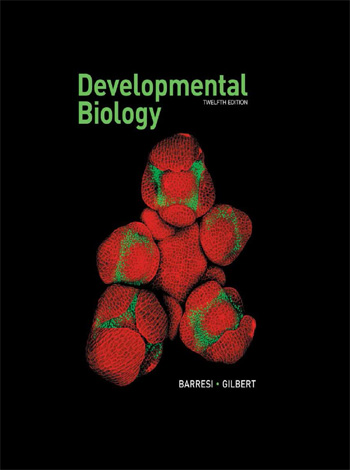
Categories |Medicine|Biology-Genetics
Hardcover: 888 pages
Language: English
ISBN-10: 1605358223
ISBN-13: 978-1605358222
Developmental Biology 12th Edition PDF Free Download
Thoroughly updated, streamlined, and enhanced with pedagogical features, the twelfth edition of Barresi and Gilbert’s Developmental Biology engages students and empowers instructors to effectively teach both the stable principles and the newest front-page research of this vast, complex, and multi-disciplinary field. This much loved, well-illustrated, and remarkably well written textbook invigorates the classical insights of embryology with cutting edge material, and makes the most complex topics understandable to a new generation of students. Designed with the undergraduate student in mind, this new, streamlined edition now contains studies of plant development, expanded coverage of regeneration, over a hundred new and revised illustrations, and deeply integrated active learning resources that build on the text’s enthusiasm and accuracy. This is a text designed to make students become excited about how animals and plants develop their complex bodies from simple origins.
The new edition makes it easier to customize one’s developmental biology course to the needs and interests of today’s students, integrating the printed book with electronic interviews, videos, and tutorials. Michael J. F. Barresi brings his creativity and expertise as a teacher and as an artist of computer-mediated learning to the book, allowing the professor to use both standard and alternative ways of teaching animal and plant development.
Table of Contents
Cover
Half Title
Front Matter
Title Page
Copyright
Dedication
Brief Contents
Contents
Preface
Reviewers of the Twelfth Edition
Media and Supplements
PART I ● Patterns and Processes of Becoming: A Framework for Understanding
Animal Development
The Making of a Body and a Field
Introduction to Developmental Biology
“How Are You, You?” Comparative Embryology and the Questions of Developmental Biology
The Cycle of Life
An animal’s life cycle
A flowering plant’s life cycle
Example 1: A Frog’s Life
Gametogenesis and fertilization
Cleavage and gastrulation
Organogenesis
Metamorphosis and gametogenesis
Example 2: Even a Weed Can Have a Flower-Full Life
Reproductive and gametophytic phases
Embryogenesis and seed maturation
Vegetative phases: From sporophytic growth to inflorescence identity
An Overview of Early Animal Development
Patterns of cleavage
Gastrulation: “The most important time in your life”
The primary germ layers and early organs
Understanding cell behavior in the embryo
A Basic Approach to Watch Development
Approaching the bench: Find it, lose it, move it
Direct observation of living embryos
Dye marking
Genetic labeling
Transgenic DNA chimeras
Evolutionary Embryology
Understanding the tree of life to see our developmental relatedness
The developmental history of land plants
Personal Significance: Medical Embryology and Teratology
Genetic malformations and syndromes
Disruptions and teratogens
Coda
Specifying Identity
Mechanisms of Developmental Patterning
Levels of Commitment
Cell differentiation
Cell fate maturation
Autonomous Specification
Cytoplasmic determinants and autonomous specification in the tunicate
Conditional Specification
Cell position matters: Conditional specification in the sea urchin embryo
Syncytial Specification
Opposing axial gradients define position
Differential Gene Expression
Mechanisms of Cell Differentiation
Defining Differential Gene Expression
A Quick Primer on the Central Dogma
Evidence for Genomic Equivalence
Anatomy of the Gene
Chromatin composition
Exons and introns
Major parts of a eukaryotic gene
The transcription product and how it is processed
Noncoding regulatory elements: The on, off, and dimmer switches of a gene
Mechanisms of Differential Gene Expression: Transcription
Epigenetic modification: Modulating access to genes
Transcription factors regulate gene transcription
The gene regulatory network: Defining an individual cell
Mechanisms of Differential Gene Expression: Pre-messenger RNA Processing
Creating families of proteins through alternative pre-mRNA splicing
Mechanisms of Differential Gene Expression: mRNA Translation
Differential mRNA longevity
Stored oocyte mRNAs: Selective inhibition of mRNA translation
Ribosomal selectivity: Selective activation of mRNA translation
microRNAs: Specific regulation of mRNA translation and transcription
Control of RNA expression by cytoplasmic localization
Mechanisms of Differential Gene Expression: Posttranslational Protein Modification
Coda
Cell-to-Cell Communication
Mechanisms of Morphogenesis
A Primer on Cell-to-Cell Communication
Adhesion and Sorting: Juxtacrine Signaling and the Physics of Morphogenesis
Differential cell affinity
The thermodynamic model of cell interactions
Cadherins and cell adhesion
The Extracellular Matrix as a Source of Developmental Signals
Integrins: Receptors for extracellular matrix molecules
The Epithelial-Mesenchymal Transition
Cell Signaling
Induction and competence
Paracrine Factors: Inducer Molecules
Morphogen gradients
Signal transduction cascades: The response to inducers
Fibroblast growth factors and the RTK pathway
FGFs and the JAK-STAT pathway
The Hedgehog family
The Wnt family
The TGF-β superfamily
Other paracrine factors
The Cell Biology of Paracrine Signaling
Focal membrane protrusions as signaling sources
Juxtacrine Signaling for Cell Identity
The Notch pathway: Juxtaposed ligands and receptors for pattern formation
Paracrine and juxtacrine signaling in coordination: Vulval induction in C. elegans
Stem Cells
Their Potential and Their Niches
The Stem Cell Concept
Division and self-renewal
Potency defines a stem cell
Stem Cell Regulation
Pluripotent Cells in the Embryo
Meristem cells of the Arabidopsis thaliana embryo and beyond
Cells of the inner cell mass in the mouse embryo
Adult Stem Cell Niches in Animals
Stem cells fueling germ cell development in the Drosophila ovary
Adult Neural Stem Cell Niche of the V-SVZ
The neural stem cell niche of the V-SVZ
The Adult Intestinal Stem Cell Niche
Clonal renewal in the crypt
Stem Cells Fueling the Diverse Cell Lineages in Adult Blood
The hematopoietic stem cell niche
The Mesenchymal Stem Cell: Supporting a Variety of Adult Tissues
Regulation of MSC development
The Human Model System to Study Development and Disease
Pluripotent stem cells in the lab
Induced pluripotent stem cells
Organoids: Studying human organogenesis in a culture dish
PART II ● Gametogenesis and Fertilization: The Circle of Sex
Sex Determination and Gametogenesis
Sex Determination
Chromosomal Sex Determination
The Mammalian Pattern of Sex Determination
Gonadal sex determination in mammals
Secondary sex determination in mammals: Hormonal regulation of the sexual phenotype
Chromosomal Sex Determination in Drosophila
Sex determination by dosage of X
The Sex-lethal gene
Doublesex: The switch gene for sex determination
Environmental Sex Determination
Gametogenesis in Animals
PGCs in mammals: From genital ridge to gonads
Meiosis: The intertwining of life cycles
Spermatogenesis in mammals
Oogenesis in mammals
Sex Determination and Gametogenesis in Angiosperm Plants
Sex Determination
Gametogenesis
Pollen
The ovule
Fertilization
Beginning a New Organism
Structure of the Gametes
Sperm
The egg
Recognition of egg and sperm
External Fertilization in Sea Urchins
Sperm attraction: Action at a distance
The acrosome reaction
Recognition of the egg’s extracellular coat
Fusion of the egg and sperm cell membranes
Prevention of polyspermy: One egg, one sperm
Activation of egg metabolism in sea urchins
Fusion of genetic material in sea urchins
Internal Fertilization in Mammals
Getting the gametes into the oviduct: Translocation and capacitation
In the vicinity of the oocyte: Hyperactivation, directed sperm migration, and the acrosome reaction
Recognition at the zona pellucida
Gamete fusion and the prevention of polyspermy
Activation of the mammalian egg
Fusion of genetic material
Fertilization in Angiosperm Plants
Pollination and beyond: The progamic phase
Pollen germination and tube elongation
Pollen tube navigation
Double fertilization
Coda
PART III ● Early Development: Cleavage, Gastrulation, and Axis
Formation
Snails, Flowers, and Nematodes
Different Mechanisms for Similar Patterns of Specification
A Reminder of the Evolutionary Context That Built the Strategies Governing Early Development
The diploblastic animals: Cnidarians and ctenophores
The triploblastic animals: Protostomes and deuterostomes
What’s to develop next
Early Development in Snails
Cleavage in Snail Embryos
Maternal regulation of snail cleavage
Axis determination in the snail embryo
Gastrulation in Snails
The Nematode C. elegans
Cleavage and Axis Formation in C. elegans
Rotational cleavage of the egg
Anterior-posterior axis formation
Dorsal-ventral and right-left axis formation
Control of blastomere identity
Gastrulation of 66 Cells in C. elegans
The Genetics of Axis Specification in Drosophila
Early Drosophila Development
Fertilization
Cleavage
The mid-blastula transition
Gastrulation
The Genetic Mechanisms Patterning the Drosophila Body
Segmentation and the Anterior-Posterior Body Plan
Maternal gradients: Polarity regulation by oocyte cytoplasm
The anterior organizing center: The Bicoid and Hunchback gradients
The terminal gene group
Summarizing early anterior-posterior axis specification in Drosophila
Segmentation Genes
Segments and parasegments
The gap genes
The pair-rule genes
The segment polarity genes
The Homeotic Selector Genes
Generating the Dorsal-Ventral Axis
Dorsal-ventral patterning in the oocyte
Generating the dorsal-ventral axis within the embryo
Axes and Organ Primordia: The Cartesian Coordinate Model
Sea Urchins and Tunicates
Deuterostome Invertebrates
Early Development in Sea Urchins
Early cleavage
Blastula formation
Fate maps and the determination of sea urchin blastomeres
Gene regulatory networks and skeletogenic mesenchyme specification
Specification of the vegetal cells
Sea Urchin Gastrulation
Ingression of the skeletogenic mesenchyme
Invagination of the archenteron
Early Development in Tunicates
Cleavage
The tunicate fate map
Autonomous and conditional specification of tunicate blastomeres
Amphibians and Fish
Early Amphibian Development
Fertilization, Cortical Rotation, and Cleavage
Unequal radial holoblastic cleavage
The mid-blastula transition: Preparing for gastrulation
Amphibian Gastrulation
Epiboly of the prospective ectoderm
Vegetal rotation and the invagination of the bottle cells
Involution at the blastopore lip
Convergent extension of the dorsal mesoderm
Progressive Determination of the Amphibian Axes
Specification of the germ layers
The dorsal-ventral and anterior-posterior axes
The Work of Hans Spemann and Hilde Mangold: Primary Embryonic Induction
Molecular Mechanisms of Amphibian Axis Formation
How does the organizer form?
Functions of the organizer
Induction of neural ectoderm and dorsal mesoderm: BMP inhibitors
Conservation of BMP signaling during dorsal-ventral patterning
Regional Specificity of Neural Induction along the Anterior-Posterior Axis
Specifying the Left-Right Axis
Early Zebrafish Development
Zebrafish Cleavages: Yolking Up the Process
Gastrulation and Formation of the Germ Layers
Progression of epiboly
Internalization of the hypoblast
The embryonic shield and the neural keel
Dorsal-Ventral Axis Formation
The fish blastopore lip
Teasing apart the powers of Nodal and BMP during axis determination
Left-Right Axis Formation
Birds and Mammals
Early Development in Birds
Avian Cleavage
Gastrulation of the avian embryo
Axis specification and the avian “organizer”
Left-right axis formation
Early Development in Mammals
Mammalian cleavage
Trophoblast or ICM? The first decision of the rest of your life
Mammalian gastrulation
Mammalian axis formation
Twins
Coda
PART IV ● Building with Ectoderm: The Vertebrate Nervous
Systyem and Epidermis
Neural Tube Formation and Patterning
Transforming the Neural Plate into a Tube: The Birth of the Central Nervous System
Primary neurulation
Secondary neurulation
Patterning the Central Nervous System
The anterior-posterior axis
The dorsal-ventral axis
Opposing morphogens
All Axes Come Together
Brain Growth
Neuroanatomy of the Developing Central Nervous System
The cells of the developing central nervous system
Tissues of the developing central nervous system
Developmental Mechanisms Regulating Brain Growth
Neural stem cell behaviors during division
Neurogenesis: Building from the bottom up (or from the inside out)
Glia as scaffold for the layering of the cerebellum and neocortex
Signaling mechanisms regulating development of the neocortex
Development of the Human Brain
Fetal neuronal growth rate after birth
Hills raise the horizon for learning
Genes for brain growth
Changes in transcript quantity
Teenage brains: Wired and unchained
Neural Crest Cells and Axonal Specificity
The Neural Crest
Regionalization of the Neural Crest
Neural Crest: Multipotent Stem Cells?
Specification of Neural Crest Cells
Neural Crest Cell Migration: Epithelial to Mesenchymal and Beyond
Delamination
The driving force of contact inhibition
Collective migration
Migration Pathways of Trunk Neural Crest Cells
The ventral pathway
The dorsolateral pathway
Cranial Neural Crest
The “Chase and Run” Model
An elaborate collaboration of pushes and pulls
Neural Crest-Derived Head Skeleton
Cardiac Neural Crest
Establishing Axonal Pathways in the Nervous System
The Growth Cone: Driver and Engine of Axon Pathfinding
Rho, Rho, Rho your actin filaments down the signaling stream
Axon Guidance
The Intrinsic Navigational Programming of Motor Neurons
Cell adhesion: A mechanism to grab the road
Local and long-range guidance molecules: The street signs of the embryo
Repulsion patterns: Ephrins and semaphorins
How Did the Axon Cross the Road?
…Netrin
Slit and Robo
The Travels of Retinal Ganglion Axons
Growth of the retinal ganglion axon to the optic nerve
Growth of the retinal ganglion axon through the optic chiasm
Target Selection: “Are We There Yet?”
Chemotactic proteins
Target selection by retinal axons: “Seeing is believing”
Synapse Formation
Ectodermal Placodes and the Epidermis
Cranial Placodes: The Senses of Our Heads
Cranial placode induction
Otic-epibranchial development: A shared experience
Morphogenesis of the vertebrate eye
Formation of the eye field: the beginnings of the retina
The lens-retina induction cascade
The Epidermis and Its Cutaneous Appendages
Origin of the epidermis
The ectodermal appendages
Signaling pathways you can sink your teeth into
Ectodermal appendage stem cells
PART V ● Building with Mesoderm and Endoderm:
Organogenesis
Paraxial Mesoderm
The Somites and Their Derivatives
Cell Types of the Somite
Establishing the Paraxial Mesoderm and Cell Fates along the Anterior-Posterior Axis
Specification of the paraxial mesoderm
Spatiotemporal collinearity of Hox genes determines identity along the trunk
Somitogenesis
Axis elongation: A caudal progenitor zone and tissue-to-tissue forces
How a somite forms: The clock-wavefront model
Linking the clock-wavefront to Hox-mediated axial identity and the end of somitogenesis
Sclerotome Development
Vertebrae formation
Tendon formation: The syndetome
Dermomyotome Development
Determination of the central dermomyotome
Determination of the myotome
Intermediate and Lateral Plate Mesoderm
Heart, Blood, and Kidneys
Intermediate Mesoderm: The Kidney
Specification of the Intermediate Mesoderm: Pax2, Pax8, and Lim1
Reciprocal Interactions of Developing Kidney Tissues
Mechanisms of reciprocal induction
Lateral Plate Mesoderm: Heart and Circulatory System
Heart Development
A minimalist heart
Formation of the heart fields
Specification of the cardiogenic mesoderm
Migration of the cardiac precursor cells
Initial heart cell differentiation
Looping of the heart
Blood Vessel Formation
Vasculogenesis: The initial formation of blood vessels
Angiogenesis: Sprouting of blood vessels and remodeling of vascular beds
Hematopoiesis: Stem Cells and Long-Lived Progenitor Cells
Sites of hematopoiesis
The bone marrow HSC niche
Coda
Development of the Tetrapod Limb
Limb Anatomy
The Limb Bud
Hox Gene Specification of Limb Skeleton Identity
From proximal to distal: Hox genes in the limb
Determining What Kind of Limb to Form and Where to Put It
Specifying the limb fields
Induction of the early limb bud
Outgrowth: Generating the Proximal-Distal Axis of the Limb
The apical ectodermal ridge
Specifying the limb mesoderm: Determining the proximal-distal polarity
Turing’s model: A reaction-diffusion mechanism of proximal-distal limb development
Specifying the Anterior-Posterior Axis
Sonic hedgehog defines a zone of polarizing activity
Specifying digit identity by Sonic hedgehog
Sonic hedgehog and FGFs: Another positive feedback loop
Hox genes are part of the regulatory network specifying digit identity
Generating the Dorsal-Ventral Axis
Cell Death and the Formation of Digits and Joints
Sculpting the autopod
Forming the joints
Evolution by Altering Limb Signaling Centers
The Endoderm Tubes and Organs for Digestion and Respiration
The Pharynx
The Digestive Tube and Its Derivatives
Specification of the gut tissue
Accessory organs: The liver, pancreas, and gallbladder
The Respiratory Tube
Epithelial-mesenchymal interactions and the biomechanics of branching in the lungs
PART VI ● Postembryonic Development
Metamorphosis
The Hormonal Reactivation of Development
Amphibian Metamorphosis
Morphological changes associated with amphibian metamorphosis
Hormonal control of amphibian metamorphosis
Regionally specific developmental programs
Metamorphosis in Insects
Imaginal discs
Hormonal control of insect metamorphosis
The molecular biology of 20-hydroxyecdysone activity
Determination of the wing imaginal discs
Regeneration
The Development of Rebuilding
Defining The Problem of Regeneration
Regeneration, a Recapitulation of Embryonic Development?
An Evolutionary Perspective on Regeneration
Regenerative Mechanics
Plant Regeneration
A totipotent way of regenerating
A plant’s meri-aculous healing abilities
Whole Body Animal Regeneration
Hydra: Stem cell-mediated regeneration, orphallaxis, and epimorphosis
Stem cell-mediated regeneration in flatworms
Tissue-Restricted Animal Regeneration
Salamanders: Epimorphic limb regeneration
Defining the cells of the regeneration blastema
Luring the mechanisms of regeneration from zebrafish organs
Regeneration in Mammals
Compensatory regeneration in the mammalian liver
The spiny mouse, at the tipping point between scar and regeneration
Development in Health and Disease
Birth Defects, Endocrine Disruptors, and Cancer
The Role of Chance
Genetic Errors of Human Development
The developmental nature of human syndromes
Genetic and phenotypic heterogeneity
Teratogenesis: Environmental Assaults on Animal Development
Alcohol as a teratogen
Retinoic acid as a teratogen
Endocrine Disruptors: The Embryonic Origins of Adult Disease
Diethylstilbestrol (DES)
Bisphenol A (BPA)
Atrazine: Endocrine disruption through hormone synthesis
Fracking: A potential new source of endocrine disruption
Transgenerational Inheritance of Developmental Disorders
Cancer as a Disease of Development
Development-based therapies for cancer
Coda
PART VII ● Development in Wider Contexts
Development and the Environment
Biotic, Abiotic, and Symbiotic Regulation of Development
Developmental Plasticity: The Environment as an Agent in Producing Normal Phenotypes
Diet-induced polyphenisms
Predator-induced polyphenisms
Temperature as an environmental agent
Reaction norms in plants
Larval settlement
Stress as an agent: The hard life of spadefoot toads
Developmental Symbioses
Developmental symbioses in plants
Mechanisms of developmental symbiosis: Getting the partners together
Developmental symbiosis in the mammalian intestine
Coda
Development and Evolution
Developmental Mechanisms of Evolutionary Change
The Developmental Genetic Model of Evolutionary Change
Preconditions for Evolution: The Developmental Structure of the Genome
Modularity: Divergence through dissociation
Molecular parsimony: Gene duplication and divergence
Mechanisms of Evolutionary Change
Heterotopy
Heterochrony
Heterometry
Heterotypy
Developmental Constraints on Evolution
Physical constraints
Morphogenetic constraints
Pleiotropic constraints and redundancy
Ecological Evolutionary Developmental Biology
Plasticity-First Evolution
Genetic assimilation in the laboratory
Genetic assimilation in natural environments
Selectable Epigenetic Variation
Evolution and Developmental Symbiosis
The evolution of multicellularity
The evolution of placental mammals
Coda
Appendix
Glossary
Index
About the Author/s
Michael J. F. Barresi is Professor of Biological Sciences at Smith College, where he has pioneered the use of a variety of technologies to engage student in novel ways with the concepts of developmental biology as well as the researchers making the discoveries of this field.
Scott F. Gilbert is the Howard A. Schneiderman Professor of Biology Emeritus at Swarthmore College and a Finland Distinguished Professor at the University of Helsinki. He has received the Viktor Hamburger Prize in teaching from the Society of Developmental Biology as well as the Alexander Kowalevsky Award in Evolutionary Developmental Biology.
You may also like

Flexible Bronchoscopy 4th Edition PDF

